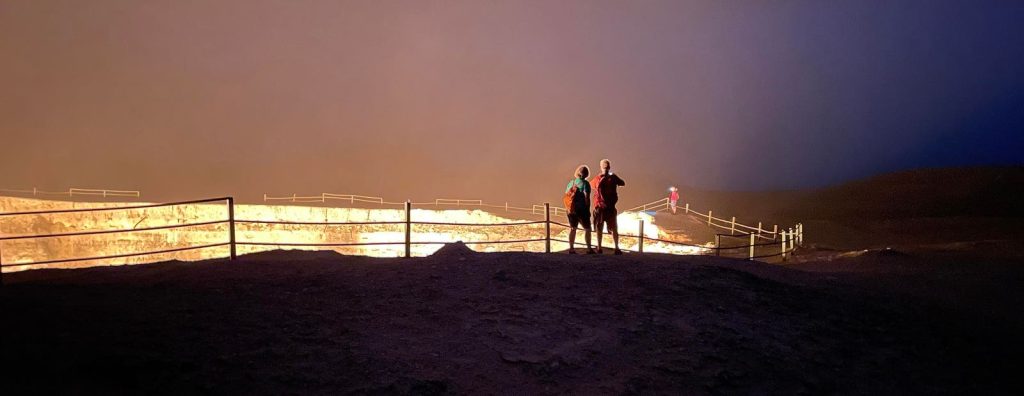Darvaza Gas Crater lights up the Karakum Desert at night.
PHOTO BY JOE YOGERST
Many (if not most) of the tourists who visit Turkmenistan each year are “country counters” — travelers determined to visit every nation on Earth.
The Central Asian destination is often at the top of their bucket list because the Turkmenistan regime makes it one of the hardest countries for tourists to enter, right up there with North Korea, Eritrea and perpetual conflict zones.
For those who don’t already know, it’s a former Soviet republic that gained its independence in the early 1990s after the disintegration of the USSR. In the wake of liberation from the Russians, the conservative post-communist regime largely closed off Turkmenistan to and from the outside world. Although it’s getting easier to visit, tourism remains a low priority.
Everyone needs a visa, and they can be difficult to obtain. And at the present time, would-be tourists need to join some kind of group to get that visa (more on that later).
That makes Turkmenistan one of the globe’s least visited nations — less than 15,000 per year is the usual guesstimate. Yet another reason it’s a geographical holy grail for so many passport stamp collectors.
Turkmenistan is often described as being strange, mysterious, odd or offbeat. Without doubt, there are times when it’s like nowhere else on the planet. But in other ways, it looks, acts and feels just like the other exotic “5 Stans” of Central Asia.
In fact, there’s far more to this desert nation than just novelty.
The famous Wedding Palace is one of Ashgabat’s most distinctive buildings.
PHOTO BY JOE YOGERST

Best High-Yield Savings Accounts Of 2024

Best 5% Interest Savings Accounts of 2024
Ashgabat: The White City
Dubbed the “White City” because so many of the buildings are faced with white marble, the national capital is also renowned for its many golden statues and colossal monuments. Most of the cars, trucks and buses are also white.
And the architecture is often out of this world. Ashgabat’s unconventional structures range from the world’s largest indoor Ferris wheel and a Wedding Palace topped by a huge golden ball, to a Ministry of Oil & Gas skyscraper shaped like a giant Bic lighter and a hotel that resembles a colossal, upturned clothes iron.
There’s not a lot of street life in the central city, even after dark when the summer heat subsides. Except at the Gulistan State Shopping Center (a.k.a. Russian Bazaar) where an amazing array of fruits, vegetables, dairy products and other edibles produced in Turkmenistan are sold at scores of stalls. Don’t be afraid to ask for samples, especially when a vendor offers a spoonful of Caspian caviar.
With its posh rooms and luxury spa, the hilltop Yyldyz Hotel is considered the city’s best digs. The drawback is the fact that it’s not walking distance from anything else. For those who want to explore on foot, old Soviet hotels in the city center are better bets. Overlooking the funky Turkmen State Circus arena, the Ak Altyn Hotel flaunts colorful Soviet-era murals, a swimming pool and Turkman carpet store.
Üzüm Cafeon Mežlauka Street is one of the easier places to dine in Ashgabat. Easy because the menu comes in English and many of the waiters are multilingual. For a cold beer, one of the best bets is the Florida British Pub near the Russian Bazaar, decorated with Laurel & Hardy statues and a large Beatles mural.
Local teenagers visiting the Neutrality Monument in Ashgabat.
PHOTO BY JOE YOGERST
Ranging Out Across Karakum Desert
Beyond white marble and golden statues, if there’s one thing that’s truly bizarre in Turkmenistan it’s the Darvaza Gas Crater.
Located around a four-hour drive north of Ashgabat via a rough desert highway, this giant flaming hole in the ground was created during the Soviet era by a natural gas rig collapsing into an underground gas pocket.
Also called the Gates of Hell, the red-hot aperture is best viewed after dark when the flames make it seem like a genuine portal to the underworld. Several nearby camps provide meals, bathrooms, and overnight accommodation in yurts.
Turkmenistan boasts five UNESCO World Heritage Sites including the ancient city of Merv, which thrived between the 3rd century BC and the 1700s as a caravan stop on the Silk Road between China and the eastern Mediterranean.
In the far north near the Uzbekistan border, the Konye-Urgench world heritage complex preserves exquisite Islamic mausoleums and minarets erected during the Middle Ages.
Turkmenistan even has a bona fide beach town — Awaza. Perched on a narrow, sandy peninsula that juts into the Caspian Sea, the resort area offers more than a dozen waterfront hotels, an indoor waterpark, and even a small maritime museum with models of ships that once plied the Caspian.
Mosaic ceiling of the Turabek Khanum Mausoleum at Konye-Urgench World Heritage Site in northern … More
PHOTO BY JOE YOGERST
Jumping Through the Hoops
A Letter of Invitation (LOI) is required from the Ministry of Foreign Affairs to obtain a tourist visa on arrival in Turkmenistan.
Although individual transit visas were once a possibility (yet still very hard to obtain), the only way to obtain an LOI nowadays is joining a group tour.
Several international travel companies are authorized by the government to guide small groups through Turkmenistan. Once you book a trip, the company will apply for your LOI and liaise with the foreign ministry on your behalf for any additional paperwork. In some cases, you may need to supply a letter stating who you are and why you want to visit Turkmenistan.
Once your LOI is approved, the travel company books your hotel rooms and ground transportation in Turkmenistan, but normally you are required to make your own airline reservations.
One of the pioneers of foreign tourism in the Central Asian nation is UK-based Lupine Travel, which offers 10-day Turkmenistan only tours that include Ashgabat, Merv and Darvaza Gas Crater, as well as two or three week “5 Stans” tours that include Turkmenistan and the region’s other former Soviet republics.
Although Turkmenistan Airlines flies nonstop between several European cities and Ashgabat, the most efficient way to get there from most places in Europe, North America and the Middle East is on daily flights via Istanbul on Turkish Airlines.
Upon arrival at Ashgabat International Airport, passengers must currently take a mandatory Covid test and present their LOI at a window where you pay (with U.S. dollars cash) for the visa and Covid test, plus an entrance fee. The visa fee depends on your nationality but the grand total for all three airport fees falls somewhere between US$60 and $100.
It’s possible to change money at the airport, but better to ask your hotel front desk about foreign exchange possibilities in the city.
A local worshiper performs a traditional counterclockwise circuit around the base of Kutlug Timur … More
PHOTO BY JOE YOGERST
Fast Facts About Turkmenistan
From the ancient Persians, Alexander the Great and Genghis Khan to Tamerlane and the Russian tsars, Turkmenistan has seen more than its fair share of invaders over the millennia.
Nowadays it’s an independent nation with around seven million people, more than 85 percent of them ethnic Turkmens who speak the Turkmen language.
With copious oil and gas reserves, energy exports fuel the economy.
While traditionally a Muslim country, during more than 70 years of Soviet rule all religion was suppressed. Since independence, the nation’s Islamic heritage has been revived to some extent, but fundamentalism is definitely verboten.
Contrary to rumors, foreign visitors are free to explore Ashgabat and the city of Dashoguz on your own rather than with a guide or group. Don’t be surprised if young residents approach to practice their English and take photos with you.
Don’t photograph government buildings or personnel, or people praying. And like many places around the globe, always ask before snapping photos of people.
The government blocks access to Facebook, Instagram, TikTok, WhatsApp and other social media and communication apps. But most hotels and many restaurants offer Wi-Fi, so it’s possible to send and receive emails. Some international telecom services (like T-Mobile) work in Ashgabat, enabling text messages and even phone calls.
Mother and daughter at their cafe in modern Konya-Urgench city.
PHOTO BY JOE YOGERST
Source: https://www.forbes.com/







More Stories
Of Toys And Tokens – In Conversation With India’s Top NFT Artist
The World’s Best Rum—According To Top Rum Experts
The Tragic Ending Of ‘Wicked,’ Explained